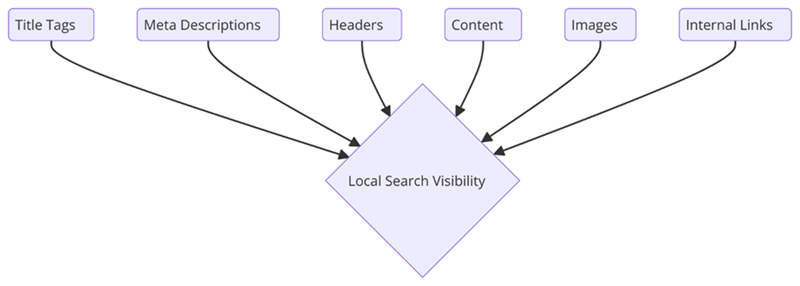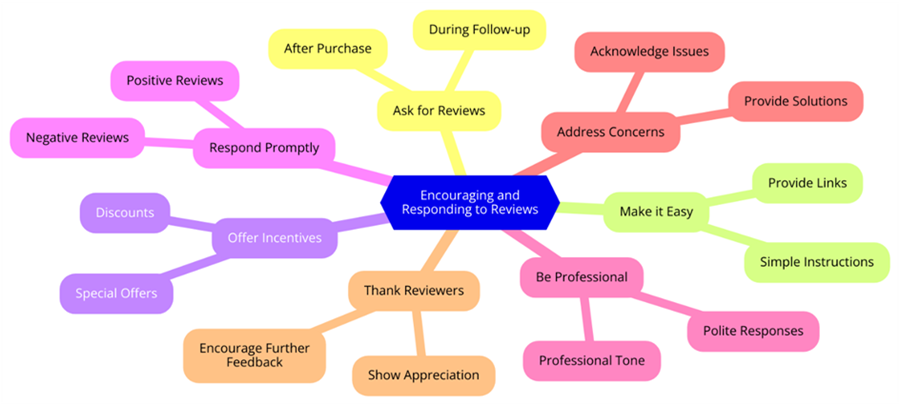Optimizing individual web pages is crucial for higher search engine rankings and increased relevant traffic. Optimizing elements on the page includes enhancing content, HTML source code, and images. On-page SEO is essential for local businesses. It allows you to focus on specific geographic areas and attract customers from the local community. Local businesses can enhance their visibility in local search results and attract more customers to their physical locations by emphasizing local keywords and optimizing on-page elements.

Improving local search visibility requires optimizing your website’s on-page elements. Make sure to include local keywords in elements like title tags, meta descriptions, headers, and content. This will help signal relevance to search engines. Increasing the chances of your business appearing in local search results and Google Maps is crucial for its relevance. Furthermore, maintaining uniform NAP (Name, Address, Phone Number) details on your website and local citations boosts your credibility and aids search engines in verifying your business information. Engaging users with high-quality, locally focused content can boost rankings and attract more local traffic.

Keyword Research and Optimization
Conducting Local Keyword Research
1. Use Tools Like Semrush’s Keyword Magic Tool to Find Relevant Local Keywords
It is crucial to conduct thorough local keyword research in order to optimize your website for local searches. Using tools like Semrush’s Keyword Magic Tool is essential for this task. Begin by inputting a general keyword that pertains to your business. Then, refine the outcomes to discover pertinent local keywords. Our tool offers suggestions for keywords, along with data on search volumes and competition levels. This will assist you in pinpointing the most effective keywords to focus on.
2. Focus on Keywords with High Search Volume and Low Competition
Choose keywords that have a high search volume and low competition for better results. When lots of people are searching for certain terms and not many businesses are targeting them, it’s a good sign. It means there’s high search volume and low competition. Maximize your chances of ranking higher in local search results and attract more potential customers with this balanced approach.
Optimizing Title Tags and Meta Descriptions
1. Include Local Keywords in Title Tags and Meta Descriptions
They offer a concise overview of your page’s content to search engines and users. Make sure to include your main local keyword in both the title tag and meta description. This will help search engines understand the relevance of your content. Boost your local search ranking with this effective strategy.
2. Ensure They Are Concise and Compelling to Improve Click-Through Rates
Make sure your title tags and meta descriptions are short and captivating. Keep your title tag concise, with fewer than 60 characters. Similarly, aim for a meta description that is no longer than 160 characters. Ensure that both descriptions effectively convey the content and entice users to visit your website. Concise and well-crafted descriptions have the power to boost your click-through rates and enhance your overall search performance.
Using Headings and Subheadings
1. Utilize H1, H2, and H3 Tags to Structure Your Content and Include Keywords
Using headings and subheadings is essential for organizing your content effectively. They provide a clear structure that improves readability and helps both users and search engines comprehend your content. For the main title, use the H1 tag. Major sections should be marked with H2 tags and subsections with H3 tags. Using local keywords in headings can boost relevance and enhance your local SEO. Content that is well-organized and concise tends to be more appealing and easier to understand for readers.
2. Make Content Easy to Read and Understand for Both Users and Search Engines
Content that is organized and easy to understand is not only user-friendly but also helps search engines. Organize your content into easily understandable sections, each with concise headings. By adopting this method, search engines can more effectively index your content, allowing users to easily locate the information they require. Organizing content effectively can help decrease bounce rates and enhance user experience.

Content Optimization
Creating Localized Content
1. Write Content that Addresses Local Issues, Events, and Interests
Crafting content that connects with your community is crucial for enhancing local search visibility. Create concise and polished blog posts, articles, and service pages that focus on relevant local topics, events, and interests. Engaging your local audience and signaling to search engines that your content is relevant to the local community are both benefits of this approach.
2. Use Local Keywords Naturally Within the Content
Include relevant local terms seamlessly within your content. Keep your content concise and focused to maintain readability and optimize for search engines. Instead, prioritize delivering valuable information that effortlessly incorporates relevant local terms. Implementing this strategy can enhance your search rankings and provide valuable content for your readers.

Building Dedicated Landing Pages
1. Create Landing Pages for Each Service Area or Location
Having separate landing pages for each service area or location can greatly improve your local SEO. Every page should focus on specific local keywords and offer comprehensive details about your services in that particular area. Using this strategy assists search engines in comprehending the geographical significance of your content.
2. Include Location-Specific Keywords and Information
Make sure every landing page has location-specific keywords and provides detailed information about your services in that particular area. Include nearby points of interest, communities, and happenings to ensure the content is relatable. Providing valuable information to potential customers not only enhances SEO but also boosts their interest.
Ensuring High-Quality and Comprehensive Content
1. Answer All Potential Customer Questions Thoroughly
Our content is top-notch, covering all customer inquiries with precision. Consider the information your customers may seek and offer comprehensive responses. Ensure your content is valuable and informative by covering a wide range of topics related to your services and local area.
2. Include Original Data, Media, and Examples to Stand Out
For your content to truly shine, it’s important to incorporate unique data, media, and examples. Enhance your content by incorporating graphs, images, videos, and case studies. Create content that captivates readers and boosts your credibility with the use of multimedia.
Technical SEO Elements
Optimizing URLs
1. Use Simple, Descriptive URLs That Include Local Keywords
Efficiently optimizing URLs is essential for enhancing user experience and boosting SEO performance. Opt for straightforward URLs that concisely convey the page’s content. Adding local keywords to your URLs enhances search engine comprehension of your page’s geographical relevance. By adopting this approach, you can improve your chances of achieving a higher ranking in local search results.
2. Avoid Using Unnecessary Parameters or Dates
Keep your URLs clean and user-friendly by avoiding unnecessary parameters or dates. Clear URLs are more user-friendly and memorable, and they also improve search engine rankings. Make sure your URLs are short and relevant to the page content.

Implementing Schema Markup
1. Add Local Business Schema to Help Search Engines Understand Your Business Details
Using schema markup can greatly enhance your local SEO efforts. Including local business schema improves search engine comprehension of your business information, including its name, address, phone number, and operating hours. Using structured data can improve your search result visibility. It gives search engines more information to index your site effectively.
2. Use Tools Like Google’s Structured Data Markup Helper to Generate the Code
You can make generating schema markup easier by utilizing tools such as Google’s Structured Data Markup Helper. Create code effortlessly for your website using this tool. Just choose the schema type, input your business details, and let the tool generate the code for you.
Improving Site Speed and Mobile-Friendliness
1. Compress Images and Minimize Code to Improve Loading Times
It is crucial to enhance site speed for optimal user experience and SEO. Efficiently shrink image files while maintaining their pristine quality. Streamline your website’s code by eliminating any extraneous elements and optimizing scripts for maximum efficiency. Improved loading times result in increased user satisfaction and improved search engine rankings.
2. Ensure Your Site Is Responsive and Performs Well on Mobile Devices
It is important to ensure that your website is responsive and mobile-friendly, especially with the growing number of mobile users. Make sure your website is responsive and delivers a smooth user experience across all devices. Google prioritizes the mobile version of your site for ranking and indexing, known as mobile-first indexing.
Enhancing User Engagement
Encouraging and Responding to Reviews
1. Prompt Customers to Leave Reviews on Google and Other Platforms
It is important to emphasize the significance of customer reviews in establishing a strong online reputation and enhancing local SEO. Encourage happy customers to share their positive experiences on popular platforms such as Google, Yelp, and Facebook. There are multiple ways to request reviews: in person, via follow-up emails, or by providing a review link on your website and in your email signature.
2. Respond to Reviews to Build Trust and Improve Your Reputation
Responding to reviews, whether they are positive or negative, demonstrates your dedication to customer feedback and your determination to enhance your business. Express gratitude to customers for their positive reviews and respond to any specific compliments they may have mentioned. When addressing negative reviews, it’s important to respond quickly and in a professional manner. Provide practical solutions to any concerns that have been raised. This interaction fosters trust and showcases exceptional customer service.

Using Internal and External Links
1. Include Internal Links to Related Pages on Your Site
Using internal links on your website can enhance user navigation and help search engines grasp the structure of your site. To enhance user engagement and prolong their stay on your website, it’s advisable to incorporate internal links to relevant pages within your content. Consider including links to other relevant blog posts, service pages, or case studies that offer more information on the topic.
2. Use External Links to Authoritative Sources to Add Value and Context
Including external links to reputable sources can enhance the credibility of your content and offer extra value to your readers. Include links to reputable websites that provide relevant information or additional resources on the subject. By adopting this approach, you can establish credibility with your audience and demonstrate to search engines that your content is reliable and informative.

Optimizing Images and Media
1. Add Descriptive Alt Text and File Names to Images
When it comes to optimizing images, it’s important to include descriptive alt text and use appropriate file names. Providing alt text for images is essential for search engine comprehension and accessibility purposes. When it’s appropriate, make sure to incorporate local keywords into the alt text. It is important to give your image files descriptive names instead of using generic ones. Implementing this technique can enhance your image search rankings and boost your overall SEO.
2. Use Images That Are Relevant to Your Local Area and Services
Utilize top-notch images that are pertinent to your specific region and offerings. Using images from your local area can add a touch of authenticity and help your audience connect with your content. Include images of your café’s location, local events, and menu items to showcase your business. These images have the power to draw in local customers and enhance the overall appeal of your website.
Conclusion
Improving local search visibility relies heavily on on-page SEO. Optimizing web pages to improve rankings and attract local traffic is a key aspect of this process. Businesses can improve their online presence and attract local customers by prioritizing local keywords, creating high-quality content, and optimizing technical elements.
Keyword optimization is crucial for ensuring that your content matches what local customers are looking for. Quality content caters to local interests and offers valuable information, enhancing user engagement and trust. Optimized URLs, schema markup, and fast, mobile-friendly sites are crucial for improving search engine understanding and user experience. This ultimately results in higher rankings and increased traffic.
It’s the perfect moment to act and enhance your local SEO. Implement the on-page SEO strategies discussed in this blog to improve your online presence and attract local customers.





